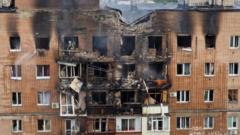Ukrainian officials confirm that a low-cost drone punctured the structure designed to contain one of the world's most hazardous nuclear incidents, highlighting vulnerabilities in disaster preparedness and nuclear engineering amid ongoing hostilities.
### Chernobyl's Shield Compromised: A Drone Strike in the Midst of War

### Chernobyl's Shield Compromised: A Drone Strike in the Midst of War
The recent drone attack on Chernobyl's protective shell has raised grave concerns over wartime threats to nuclear safety.
In February, an incident at the Chernobyl nuclear power plant shattered expectations set by engineers and safety analysts who breathed life into a structure anticipated to withstand various calamities but never the realities of war.
The New Safe Confinement, a colossal steel structure weighing nearly 40,000 tons, was erected as a barrier over Reactor No. 4, the site of the catastrophic 1986 disaster, with significant international investment and expertise. Retired civil engineer Eric Schmieman, who contributed to this monumental project over a decade and a half, described the comprehensive safety measures taken—earthquakes, heavy winds, and extreme weather were all accounted for, yet “acts of war” were dismissed as a potential threat.
On February 14, a Shahed 136 drone believed to be of Russian origin struck the shield, creating a damaging hole. Priced at approximately $20,000, the attack caused a chain reaction that led to internal fires, which smoldered for weeks due to insulated waterproof membranes igniting and requiring emergency measures from responders. Ukrainian officials detail the urgent efforts, which involved climbing equipment to locate and extinguish the fire inside a structure designed to remain dry and prevent corrosion.
This alarming incident has reignited discussions around nuclear safety in conflict zones, emphasizing the need for better safeguards and strategic assessments that account for evolving threats in the realm of warfare. The consequences of undermining such critical infrastructure can lead to devastating repercussions, far exceeding the scope of military engagement.
The Chernobyl incident serves as a harsh reminder: while historical disasters shape our understanding of safety, the unpredictable nature of modern warfare presents an additional layer of risk that current engineering practices need to address.
The New Safe Confinement, a colossal steel structure weighing nearly 40,000 tons, was erected as a barrier over Reactor No. 4, the site of the catastrophic 1986 disaster, with significant international investment and expertise. Retired civil engineer Eric Schmieman, who contributed to this monumental project over a decade and a half, described the comprehensive safety measures taken—earthquakes, heavy winds, and extreme weather were all accounted for, yet “acts of war” were dismissed as a potential threat.
On February 14, a Shahed 136 drone believed to be of Russian origin struck the shield, creating a damaging hole. Priced at approximately $20,000, the attack caused a chain reaction that led to internal fires, which smoldered for weeks due to insulated waterproof membranes igniting and requiring emergency measures from responders. Ukrainian officials detail the urgent efforts, which involved climbing equipment to locate and extinguish the fire inside a structure designed to remain dry and prevent corrosion.
This alarming incident has reignited discussions around nuclear safety in conflict zones, emphasizing the need for better safeguards and strategic assessments that account for evolving threats in the realm of warfare. The consequences of undermining such critical infrastructure can lead to devastating repercussions, far exceeding the scope of military engagement.
The Chernobyl incident serves as a harsh reminder: while historical disasters shape our understanding of safety, the unpredictable nature of modern warfare presents an additional layer of risk that current engineering practices need to address.























